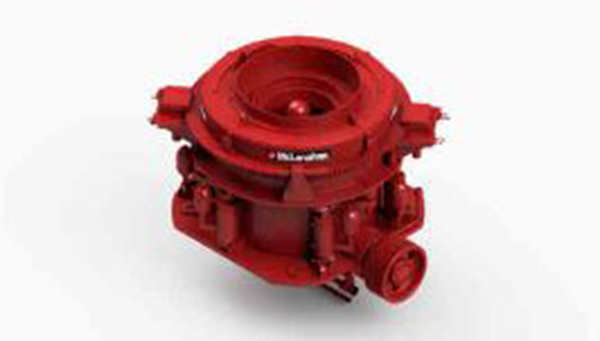Cone Crushers

Cone Crushers
A Cone Crusher is a compression type of machine that reduces material by squeezing or compressing the feed material between a moving piece of steel and a stationary piece of steel.
Applications
A Cone Crusher will deliver a 4:1 to 6:1 reduction ratio. As we set the closed side setting tighter to create a finer output, we also reduce the volume or throughput capacity of the machine. Generally speaking, multiplying the closed side setting by two is a good guide to the top size of the gradation exiting the machine.
A general rule of thumb for applying Cone Crushers is the reduction ratio. A crusher with coarse style liners would typically have a 6:1 reduction ratio. Thus, with a 3⁄4” closed side setting, the maximum feed would be 6 x 3⁄4 or 4.5 inches. Reduction ratios of 8:1 may be possible in certain coarse crushing applications. Fine liner configurations typically have reduction ratios of 4:1 to 6:1.
Final sizing and reduction is determined by the closed side setting or the gap between the two crushing members at the lowest point. As the wedge or eccentric rotates to cause the compression within the chamber, the material gets smaller as it moves down through the wear liner as the opening in the cavity gets tighter. The crushed material is discharged at the bottom of the machine after they pass through the cavity.
HOW A CONE CRUSHER WORKS
In the Symons principle, which is utilized by the MSP Cone Crusher, each cycle is timed so that the feed material and the upward thrust of the crushing head meet at the moment of maximum impact. The optimum speed of gyration and the large eccentric throw produce two important results: 1) the rapidly closing head catches the falling feed material and delivers the extremely high crushing force and 2) on the other side of the chamber the rapidly receding head allows material to fall freely to the next point of impact or exit the chamber. The combination of superior crushing force and free flow of material in the MSP Cone Crusher results in production levels that are unsurpassed and means lower power consumption per ton.
Ten years of testing went into the final combination of speed, stroke, and head angle to deliver the most efficient use of power. Greater efficiency delivers lower power consumption, reduced cost per ton, less maintenance and higher profits.
The power input imparted by the driven eccentric results in a bearing force in opposition to the crushing force at a point on the lower portion of the main shaft. The bearing force as it is transmitted to the main shaft provides the required moment to crush the rock. The distance between the bearing force and the fulcrum point is called the force arm. The longer the force arm, the greater the momentum, which produces a greater crushing force.
Crushing loads are distributed over a large spherical bearing. The socket liner keeps full contact with the crushing head ball and carries all of the vertical component and part of the horizontal. The long force arm, represented by the main shaft, reduces the load transmitted through the eccentric bushing.
Capacities and product gradations produced by Cone Crushers are affected by the method of feeding, characteristics of the material fed, speed of the machine, power applied, and other factors. Hardness, compressive strength, mineral content, grain structure, plasticity, size and shape of feed particles, moisture content, and other characteristics of the material also affect production capacities and gradations. Gradations and capacities are most often based on a typical, well-graded choke feed to the crusher. Well-graded feed is considered to be 90% to 100% passing the closed side feed opening, 40% to 60% passing the midpoint of the crushing chamber on the closed side (average of the closed side feed opening and closed side setting), and 0 to 10% passing the closed side setting. Choke feed is considered to be material located 360 degrees around the crushing head and approximately 6” above the mantle nut. Maximum feed size is the average of the open side feed opening and closed side feed opening.
Minimum closed side setting may vary depending on crushing conditions, the compressive strength of the material being crushed, and stage of reduction. The actual minimum closed side setting is that setting just before the bowl assembly lifts minutely against the factory recommended pressurized hydraulic relief system.
Overall, industry acceptance of the Symons principle and performance, the McLanahan Cone Crusher works to deliver lower recirculating loads at higher tonnage rates with lower maintenance costs by combining:
A long parallel zone for uniform, accurate sizing of product
An ideal gyrating cycle that delivers quick hammer-like blows on free falling material
Contact between the gyrating head and falling material that rearranges particles before each impact
Adjustment of the upper crushing member by rotation, giving even liner wear and maintaining setting accuracy around the entire crushing chamber
High impacts to reduce the hardest materials more effectively
Large head displacement, allowing a greater volume of material flow at every cycle
More energy concentrated on crushing with minimal surface friction, resulting in low kw/ton consumption